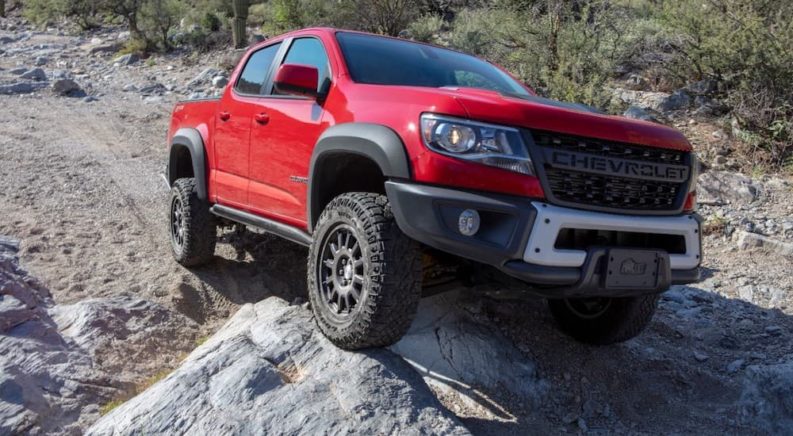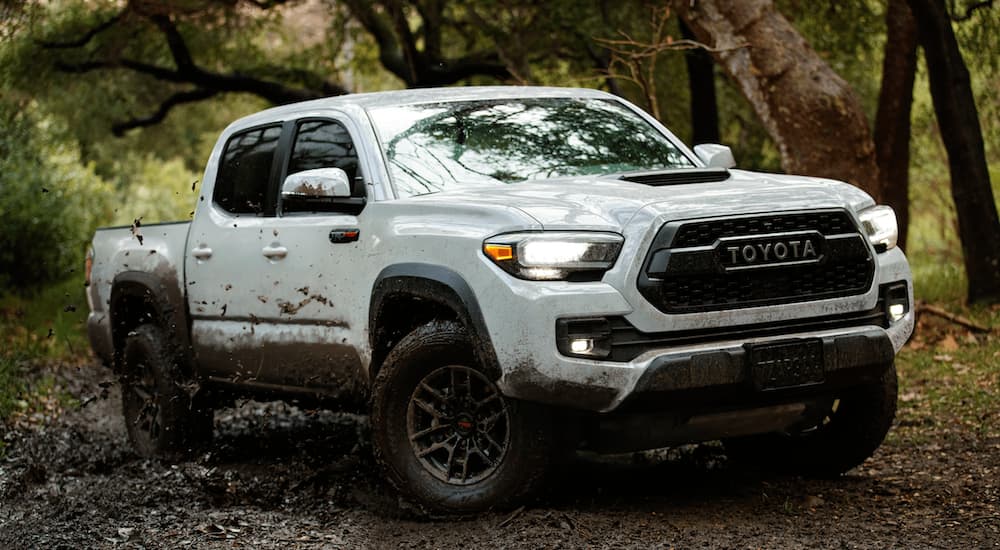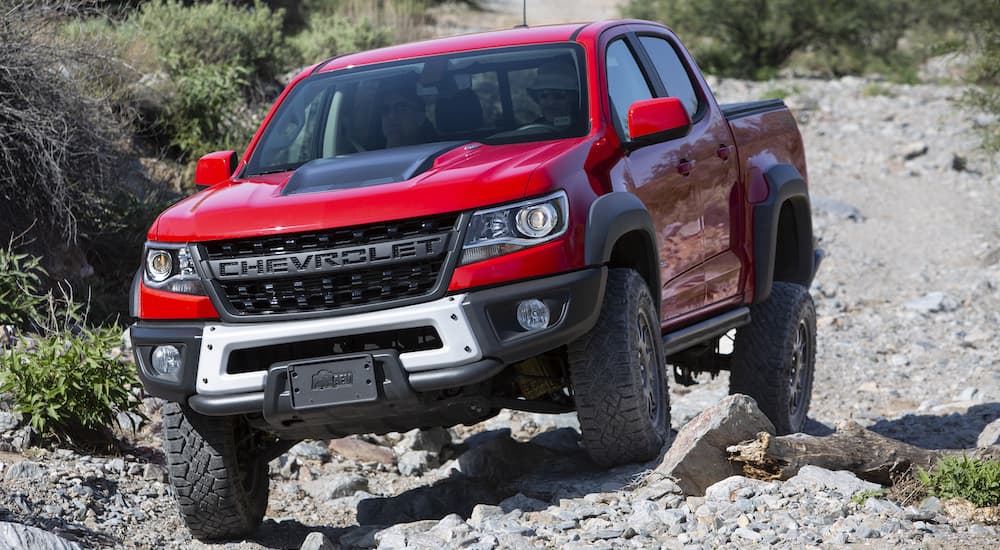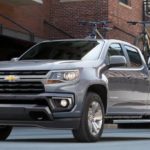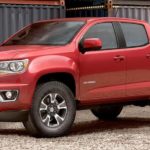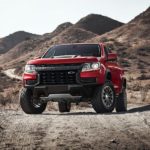Many trace the modern off-roader’s origin to 2008, when Ford’s Performance division set out to produce a pickup inspired by the desert racing scene. While some might have scoffed at the project at the time, the results were undeniable, with the Ford F-150 Raptor becoming an instant best-seller upon its debut. Other automakers took note and got to work designing their own high-performance off-road pickups, including midsize models like the 2022 Chevy Colorado and 2022 Toyota Tacoma, a trend that’s now even spread to the booming crossover SUV market.
In some ways, these off-road trims just mark a return to pickup truck’s rough-and-tumble roots when the hardworking vehicles were regularly put through their paces in a variety of challenging road conditions. Fuel economy standards and changing consumer tastes have seen many trucks give up some of their more rugged features, but that trend seems to now be swinging in the opposite direction, with every major US automaker now producing some sort of dedicated off-road trim.
Many of today’s off-road models tend to run the gamut from off-road “inspired” trims that offer little in the way of actual performance upgrades to high-performance off-road rigs that are so well kitted out as to be almost impractical as a daily driver. Some automakers have managed to split the difference, rolling out two off-road models that strike a nice balance between functionality and practicality, but how do the two models stack up against one another? Let’s look at two prime examples––the 2022 Chevy Colorado vs 2022 Toyota Tacoma––and see how automakers have been busy at work injecting a little off-road excitement into these midsize pickups.
Colorado ZR2 Bison
First introduced in 2017, the Chevy Colorado ZR2 is an off-road trim that includes everything an off-road enthusiast could ask for in a truck. Features range from a 2-inch lift and 3.5-inch wider track to Multimatic Dynamic Suspension Spool Valve (DSSV) Dampers, electronic locking front and rear differentials, skid plates, rock sliders, and more. It wasn’t Chevy’s first attempt at an off-road-specific trim, but the ZR2 kicks everything up a notch with a host of impressive upgrades and heavy-duty off-road components that make the trim the most capable in the lineup.
Not sold on the ZR2’s off-road prowess? Well, the US military doesn’t share your concerns. The Army’s Infantry Squad Vehicle is basically a diesel version of the ZR2, with 90 percent of the vehicle constructed from the same commercial components one will find in the civilian model. If you’re looking for third-party confirmation of the Chevy ZR2’s off-road performance, it’s hard to do much better than that.
For 2019, Chevy has upped the ante once again, introducing a new limited edition of the ZR2 trim dubbed the Colorado ZR2 Bison. The enhanced midsize pickup features a powerful 2.8L Duramax diesel engine and a generous slate of intriguing off-road equipment. Chevy has also teamed with off-roading equipment supplier American Expedition Vehicles (AEV) to give many of the existing components a heavy-duty upgrade that ensures they’ll withstand the rigors of off-road life. After being given the AEV touch, the ZR2 Bison’s skid plates are upgraded to boron steel, with the pickup’s front and rear bumpers also getting steel upgrades. The wheel arch flares are upsized as well, but it’s the ZR2’s shocks and differentials that truly allow the pickup to excel in the off-road category.
The truck features innovative Multimatic DSSV dampers, which use spool valves rather than traditional piston-and-shim construction to offer an exceptionally smooth ride over even the roughest terrain. They can be adjusted to offer a softer or firmer ride, depending on the scenario, and also offer exceptional performance in higher temperatures as the hydraulic fluid used in the Multimatic dampers is more resistant to heat.
The front and rear electronic locking differentials are another highlight when it comes to the ZR2 Bison. While rear locking differentials have become the norm in many off-road-oriented trucks, the inclusion of a front locking differential is far less common. The front locking differential allows the front wheels to lock together when one wheel isn’t getting enough traction, routing power to the wheel with traction and propelling drivers through even the hairiest off-road scenario. This comes in handy during low-speed off-road maneuvers, allowing drivers to scale steep grades without worry.
Tacoma TRD Pro
Toyota has been slapping the TRD tag on high-performance and off-road versions of its popular pickups since 1997. Short for Toyota Racing Development––the brand’s in-house tuning outfit––the TRD models typically include a number of upgraded components, including locking rear differentials, upgraded shocks, and the like. TRD models for the Toyota Tacoma typically come in two distinct versions: the TRD Sport and TRD Off-Road, with the latter focusing on the inclusion of rugged components that go a long way in ensuring success out on the trail.
Toyota has also rolled out a no-holds-barred version of the popular TRD models dubbed the TRD Pro. The highest-end version of the Tacoma folds in many of the off-road upgrades found on the TRD Off-Road but rounds out the pickup with a generous suite of creature features that help to justify the inflated price tag. The 2021 TRD Pro gets a 1.5-inch suspension lift, improved approach, breakover, and departure angles, forged upper control arms, and new 16-inch TRD wheels with Goodyear Wrangler Territory All-Terrain tires.
There are also some clever tech features that go a long way in upping the pickup’s off-road bona fides, such as Toyota’s Multi-Terrain Monitor, which stitches together multiple live camera views to give drivers a handy view of their surroundings. While it’ll certainly make parking the Tacoma easier, the real purpose behind the Multi-Terrain Monitor is to give drivers a better look at the potentially trip-ending obstacles they might encounter out on the trail.
The TRD Pro also looks every bit the off-roader with aggressive styling, enhanced cladding, and eye-catching color options such as Electric Lime Metallic, but where it really counts, the pickup can be a bit lacking. For example, the TRD Pro features the same 3.5L V6 found on the base model Tacoma. While it’s not exactly underpowered at 278 hp and 265 lb-ft of torque, we would expect a little more given the significantly higher price. That’s not to say the TRD Pro can’t hold its own when it comes to off-road power, but instead of including a cat-back exhaust to increase engine noise Toyota could have just as easily improved the actual engine itself.
Real Off-Road Trims
Regardless of which model you choose, this new generation of off-road trims holds a lot of potential for drivers eager to try their hand at a more challenging type of driving. By melding the familiar platform of some of the country’s best-loved pickups with the heavy-duty components and features that allow a vehicle to truly excel in off-road scenarios, these trucks provide the perfect excuse to explore the road less traveled from behind the wheel of a rugged and capable 4×4. Just remember, not all off-road trims are created equal.
While some automakers are content to slap an off-road badge on any model with a steel bumper and big tires, others take a more practical approach by emphasizing those less-obvious components that can have a big impact on a driver’s off-road success. While some trims are undeniably more well equipped than others, there’s no one-size-fits-all solution when it comes to choosing the perfect off-roader. Drivers should consider what type of off-roading they’re most interested in and then choose a rig that best suits their needs because the same pickup that’s ideal for climbing steep rock faces might not hold up quite as well if you’re looking to splash around in some mud or sand.

